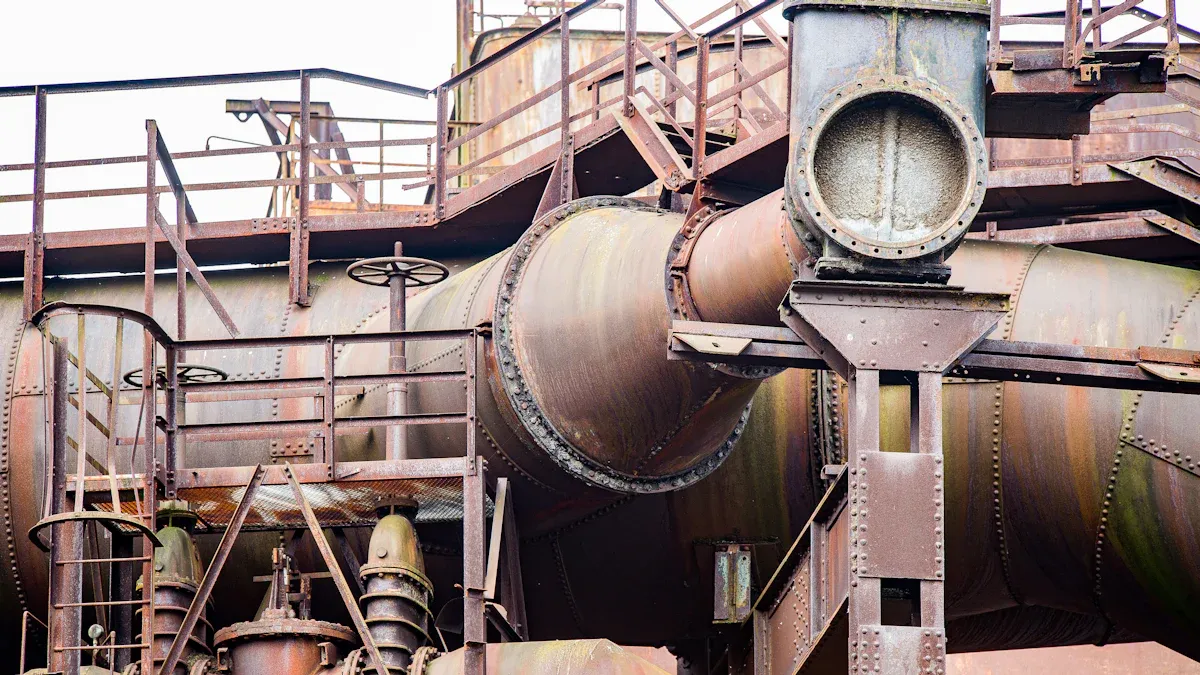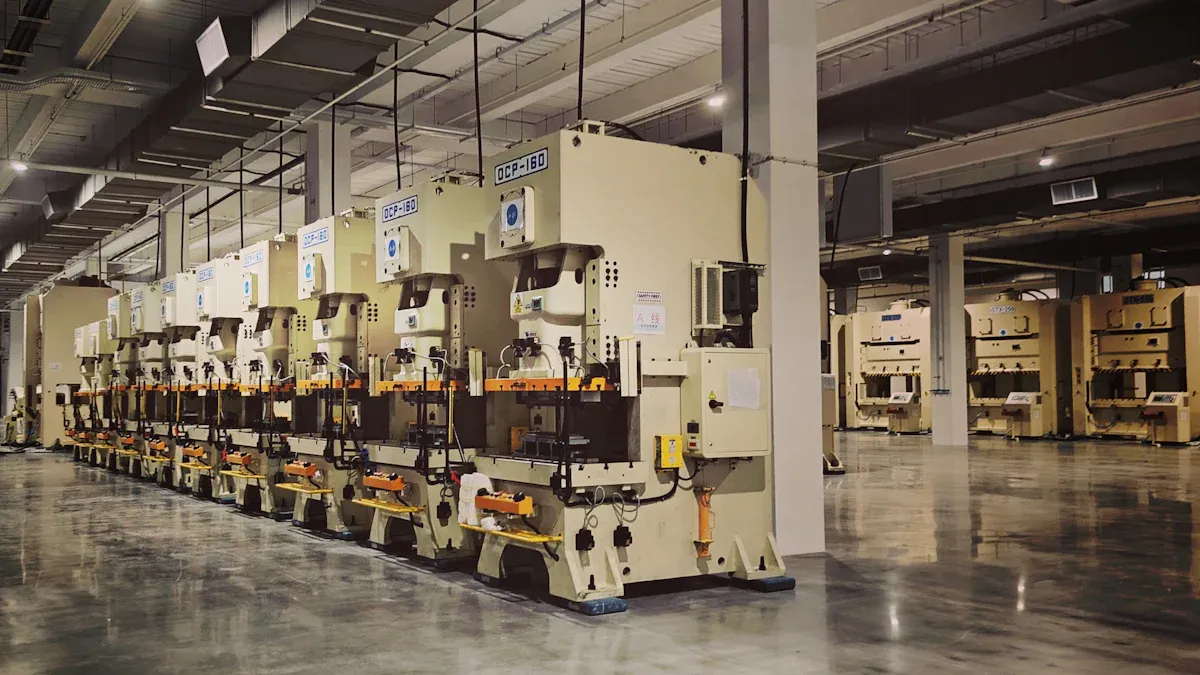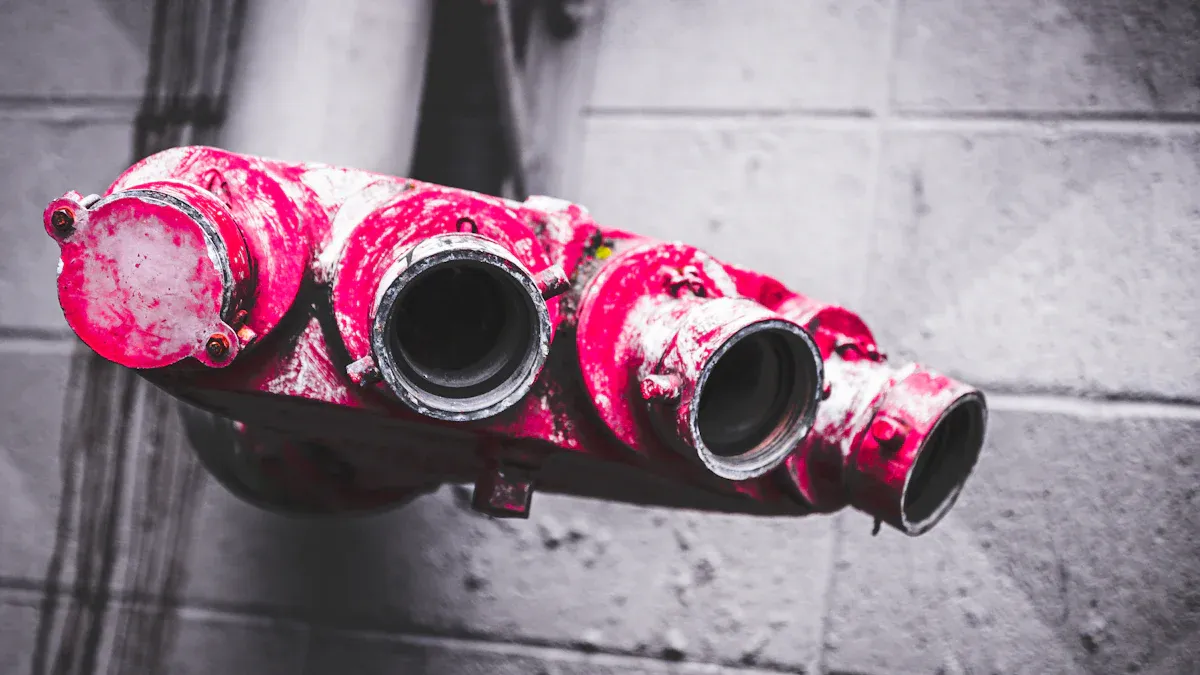
Selecting hose fittings for industrial use starts with knowing the fluid type, pressure, and temperature needs. Users check if hydraulic fittings, stainless steel hose connector, or Parker hose fittings fit the job. They avoid mismatches to prevent leaks or damage. Many consult experts when choosing hydraulic hose fittings for safety.
Key Takeaways
- Know your system’s fluid type, pressure, and temperature needs before choosing hose fittings to prevent leaks and damage.
- Match hose fitting materials and sizes carefully to the application and environment for safety, durability, and better performance.
- Follow industry standards, perform regular inspections, and work with expert suppliers to keep hose systems safe and reliable.
Identify Application Requirements for Hose Fittings

Determine Fluid Type and Compatibility
Choosing the right hose fittings starts with knowing what kind of fluid will flow through the system. Some fluids, like oil or chemicals, need special materials to prevent leaks or damage. Hydraulic hoses have layers that protect against different fluids. For example, PTFE-lined hoses work well with harsh chemicals and high temperatures. Rubber hoses handle heat and stay flexible. Thermoplastic hoses resist abrasion and suit high-pressure jobs. Industry standards, such as SAE J517 and ISO 18752, help users match hoses and fittings to fluid types. The STAMPED rule (Size, Temperature, Application, Materials, Pressure, Ends, Delivery) guides users to consider all important factors.
Tip: Always check if the fitting material matches the fluid. Using the wrong type can cause early failure.
Assess Pressure and Temperature Ratings
Pressure and temperature ratings matter a lot in industrial settings. Working pressure means the highest safe pressure during normal use. Burst pressure gives a safety margin, usually three to four times higher than working pressure. For example, hydraulic hoses in oil and gas often need a working pressure of 5,000 PSI. Temperature also affects pressure ratings. If the hose faces high heat, its pressure rating drops. Fittings must meet or exceed the hose’s pressure rating to keep the system safe.
Consider Environmental and Physical Conditions
Environmental and physical conditions can shorten the life of hose fittings. Sunlight, moisture, and chemicals break down materials over time. UV rays cause cracking, while moisture leads to corrosion. Dust and dirt wear out surfaces. Sharp bends and vibration create stress points. Proper installation and regular checks help prevent these problems. Choosing the right material and routing the hose carefully keeps the system running longer.
| Key Factor | Explanation | Considerations |
|---|---|---|
| Operational Environment | Includes temperature, pressure, and fluid type affecting fitting material and performance. | Use heat-resistant materials for high temps; select materials maintaining strength in cold; ensure pressure rating exceeds max system pressure. |
| Material Compatibility | Compatibility between fluid and fitting material to prevent degradation and leaks. | Match fitting materials to hydraulic fluids like mineral oils, water-glycol, or synthetics to avoid chemical reactions. |
| Fitting Type and Style | Different fitting types (JIC, NPT, BSP, ORFS) suit various applications and sealing needs. | Choose fittings based on pressure, leak prevention, ease of assembly, and application environment. |
| System Compatibility | Ensuring fittings match hose and system specifications for reliable connections. | Consider thread types, sealing methods, and standards relevant to the system and region. |
| Assembly and Installation | Proper torque and alignment critical to avoid leaks, pressure drops, and system failures. | Apply correct torque; ensure alignment to prevent stress, wear, and premature failure. |
Select Hose Fittings Materials for Compatibility
Match Material to Fluid and Application
Choosing the right material for hose fittings helps keep systems safe and working well. Each fluid needs a special type of fitting. For example, stainless steel works great for clean environments and resists rust. PTFE and PFA couplings handle strong chemicals and stop metal from touching the fluid. Permanent crimp collars give extra security for chemical jobs. Design engineers look at the fluid type, pressure, and temperature before picking a material. They also think about how the hose will be used.
Here’s a quick look at common hose types and their best materials:
| Hose Type | Typical Applications | Recommended Materials | Key Features and Considerations |
|---|---|---|---|
| Chemical Hoses | Acids, solvents, corrosive chemicals | PTFE, UHMWPE, XLPE | High chemical resistance, stops leaks |
| Food and Beverage | Food processing, beverage transfer | Nitrile rubber, PVC | Safe for food, easy to clean |
| Material Handling | Sand, cement, grains | Reinforced rubber, polyurethane | Tough against wear, lasts longer |
| Petroleum Hoses | Gasoline, diesel, oil | Nitrile rubber, oil-resistant compounds | Handles oil, resists weather |
| Steam Hoses | Cleaning, heating, steam | EPDM rubber | Stands up to heat and pressure |
| Water Hoses | Water transfer, cleaning | Rubber, PVC | Flexible, strong, resists damage |
Tip: Always match the fitting material to the fluid and job. This helps prevent leaks and keeps the system safe.
Evaluate Corrosion and Chemical Resistance
Corrosion and chemical resistance matter a lot in industrial settings. Stainless steel fittings last longer because they fight rust and work in tough places. Brass fittings stand up to water, salt, and many fluids, so they fit harsh environments. PPR fittings, made from polypropylene, do not react with water or chemicals. This keeps them strong and safe for a long time. Some fittings use special coatings to block rust and damage. For example, advanced coatings can protect fittings for thousands of hours in salt spray tests. When engineers choose hose fittings, they look for materials that keep their strength and do not break down. This means fewer leaks, less maintenance, and safer systems.
Note: Picking the right material for corrosion resistance saves money and keeps the system running longer.
Choose Hose Fittings Type and Size

Identify Thread Type and End Style
Selecting the right thread type and end style helps prevent leaks and keeps the system safe. Industrial hose fittings use different thread standards like NPT, BSP, and metric. Each thread type fits certain systems and regions. O-Ring Face Seal (ORFS) fittings work well for high-pressure jobs, while mated angle fittings use flared surfaces for sealing. Tapered threads seal by wedging, but they can leak if not installed correctly. Common shapes include straight, elbow, tee, cross, and flange. Each shape connects hoses in different ways, like changing direction or splitting flow.
| Aspect | Straight Threads | Tapered Threads | End Style Examples |
|---|---|---|---|
| Sealing Mechanism | Needs O-rings or gaskets | Seals by wedging threads | Flare, compression, ORFS |
| Pressure Rating | Up to 5,000 PSI | Up to 15,000 PSI | Metal-to-metal, O-ring face |
| Reliability | Needs extra sealing | Needs sealant, careful torque | Compression improves grip |
Tip: Always match the thread standard to your system to avoid cross-threading and leaks.
Select Proper Sealing Method
Sealing methods keep connections tight and leak-free. O-ring seals use rubber rings to block fluid. Compression seals press parts together for a strong hold. Flanged seals use metal or rubber rings squeezed by bolts. Tapered threads often need PTFE tape or sealant. Metal-to-metal seals work with flared fittings. Clean parts and use the right torque for best results. Regular checks help spot worn seals before leaks start.
Confirm Size and Flow Rate Requirements
Size and flow rate matter for safe and efficient operation. Hose size is measured by inner diameter, often shown in dash numbers. Flow rate depends on pump ratings and system needs. Too small a hose increases heat and pressure, risking damage. Too large a hose lowers efficiency. Suction hoses need to be bigger than pressure hoses. Using sizing charts or nomographs helps pick the right size for your job.
- Hose size affects fluid speed and pressure.
- Correct size prevents leaks and system damage.
- Always match hose and fitting size for best performance.
Ensure Hose Fittings Meet Standards and Safety Regulations
Check Industry and Regulatory Standards
Every industry sets its own rules for safety and performance. In 2025, metal hose fittings must follow strict health and safety regulations based on where they get used. For example, food and beverage plants need hoses that stop contamination and resist corrosion. These hoses must also stay clean and meet food safety rules. Hydrogen fueling stations need hoses that do not leak, even under high pressure. They must also resist damage from flammable gases. Aerospace companies want hoses that handle extreme pressure, big temperature changes, and harsh chemicals. These rules help keep people safe and protect the environment. Companies should always check the latest standards for their industry before choosing hose fittings.
Review Safety Ratings and Certifications
Safety ratings and certifications show that hose fittings can handle tough jobs. Many groups test and approve these products. The table below shows how different ratings help with safety and risk management:
| Aspect | Description | Impact on Compliance and Risk Management |
|---|---|---|
| Recognized Standards | ISO, SAE, EN, UL, CE Marking, CSA | Ensure hose fittings meet safety, performance, and environmental requirements, reducing risk of failures and hazards. |
| Safety Assurance | Materials, construction, and testing procedures (pressure, temperature, fire resistance) | Minimizes risk of leaks, ruptures, and hazardous incidents, protecting personnel and equipment. |
| Performance Reliability | Burst pressure, flexibility, thermal degradation resistance | Guarantees consistent performance under extreme conditions, supporting system reliability. |
| Compatibility and Interchangeability | Standardized dimensions and fittings | Facilitates integration into existing systems, reducing modification needs and ensuring system compatibility. |
| Certification Benefits | Market access, customer confidence, reduced liability | Certifications enable regulatory compliance, enhance trust, and limit legal risks. |
| Testing Types | Pressure testing (burst and operating), temperature endurance, thermal shock, material and fire resistance | Verifies hose durability and safety under operational stresses, preventing unexpected failures and accidents. |
| Regular Inspection and Maintenance | Visual checks, component replacement, proper routing | Sustains long-term safety and operational efficiency, preventing downtime and failures. |
Many countries have their own approval systems. Some examples include:
- DOT and TPED for cylinders in the US and Europe
- DVGW and TUV for gas and water in Germany
- METI for valves and fittings in Japan
- KGSC for toxic gas valves in Korea
- ISO 9001 for quality management
Tip: Always look for trusted certifications when picking hose fittings. These marks help ensure safety and build trust with customers.
Consider Installation and Maintenance of Hose Fittings
Evaluate Bend Radius and Flexibility
Bend radius and flexibility play a big role in how long a hose lasts. When workers bend a hose too much, it can kink or crack. This leads to leaks and lower flow. Every hose has a minimum bend radius. If someone bends it tighter than that, the inside can break down. Braided hoses bend more easily and fit tight spaces. Spiral hoses need bigger bends but handle higher pressure. Smaller hoses bend tighter, while bigger hoses need more space. Following the manufacturer’s bend radius keeps the system safe and cuts down on repairs.
Tip: Always check the hose label or manual for the minimum bend radius. Using the right bend helps avoid early hose failure.
Plan for Length and Routing
Planning hose length and routing helps prevent stress and damage. Hoses should follow the shortest, smoothest path. Workers should avoid sharp bends and twists. Clamps and straps keep hoses in place and stop them from rubbing or moving. Adding a little slack lets hoses move with machines and handle pressure changes. Covers or sleeves protect hoses from heat and rough surfaces. Good routing also makes it easy to check or replace hoses later.
Here are some best practices for routing:
- Use gradual bends, not sharp corners.
- Secure hoses with clamps, but do not squeeze them too tight.
- Keep hoses away from hot parts and chemicals.
- Allow slack for movement and thermal changes.
- Bundle hoses carefully to stop chafing.
Assess Ease of Installation and Maintenance
Easy installation and maintenance save time and money. Simple designs with clear threads and connections help workers fit hoses quickly. Using the right tools, like torque wrenches, stops leaks from over-tightening. Regular checks catch wear, leaks, or loose fittings before they cause trouble. Cleaning hoses with mild soap keeps them free from dirt and blockages. Storing hoses in cool, dry places away from sunlight helps them last longer. Training workers on these steps keeps the system running and lowers repair costs.
Note: Investing in quality hose fittings and planning for easy maintenance reduces downtime and keeps operations smooth.
Evaluate Hose Fittings Supplier Support and Customization
Review Technical Support and Expertise
Strong technical support makes a big difference when choosing hose fittings for industrial use. Suppliers with hands-on experience can quickly spot what a system needs. They often solve problems just by looking at a hose sample. Their advice helps buyers pick the right fittings, which keeps systems safe and running well. Many suppliers offer technical assistance for installation, maintenance, and troubleshooting. This support reduces downtime and helps workers avoid mistakes. Some suppliers even have pressure testing facilities to check safety and performance. Local experts can respond fast in emergencies, saving time and money.
Tip: Look for suppliers who offer expert consultation and have a good service network. This helps with planning and keeps systems reliable.
Consider Custom Solutions and Availability
Every industry has unique needs. Many suppliers now offer custom hose fittings and assemblies. They can make hoses in special lengths or with different end connections. Some companies, like Ameraseal, let customers bring in samples or specs for quick, tailored solutions. Online tools help users pick hose style, size, and ends. Custom options reduce leaks and fit tight spaces better. Suppliers also provide fittings for special jobs, like food, beverage, or pharmaceutical use. Fast turnaround and a wide range of choices help businesses stay on schedule.
| Customization Aspect | Description |
|---|---|
| Precise Fit | Custom lengths and diameters improve flow and save space. |
| Variety of End Connections | Many end types and hose styles fit unique needs. |
| Reduced Risk of Failure | Custom engineering lowers leaks and boosts reliability. |
| Industry-Specific Options | Solutions for food, beverage, and pharma with safety in mind. |
Assess After-Sales Service and Warranty
After-sales service and warranty policies matter a lot. Good suppliers stand by their products with clear warranties. This gives buyers peace of mind and shows the supplier trusts their own quality. Reliable suppliers offer spare parts, repairs, and help after the sale. They answer questions fast and provide documents or certifications when needed. Customer reviews and a strong reputation show if a supplier delivers on promises. Watch out for unclear policies or poor support, as these can lead to problems later.
| Aspect | Description | Impact on Reliability and Satisfaction |
|---|---|---|
| Warranty & Return Policy | Covers defects, returns, and damage handling. | Builds trust and protects against product issues. |
| Spare Parts & Support | Offers replacements and stock for repeat orders. | Makes maintenance easy and keeps systems running. |
| Customer Reviews | Shows real feedback and service quality. | Reflects supplier credibility and after-sales support. |
| Red Flags | Vague policies or poor support. | Warns buyers and reduces risk. |
Choosing Hose Fittings with a step-by-step process helps workers avoid leaks and system failures. They get better safety, durability, and performance. Experts give advice on pressure ratings and material compatibility. Regular inspections and supplier support keep systems running smoothly. Always put safety and compatibility first for every job.
FAQ
What happens if someone uses the wrong hose fitting material?
Using the wrong material can cause leaks or damage. The system may fail early. Always match the fitting to the fluid and job.
How often should workers inspect hose fittings?
Workers should check hose fittings every month. Regular inspections help spot wear, leaks, or loose parts before bigger problems start.
Can a supplier help with custom hose fitting solutions?
Yes! Many suppliers offer custom fittings. They can design parts for special jobs or unique spaces. Ask for expert advice when needed.
Post time: Aug-18-2025
